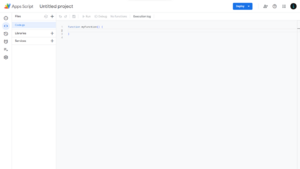Google Apps Script
Topic: Software
 From HandWiki - Reading time: 4 min
From HandWiki - Reading time: 4 min
 | |
| Developer(s) | |
|---|---|
| Initial release | August 19, 2009[1] |
| Written in | JavaScript |
| Type | Web application framework, scripting framework |
| Website | script |
Google Apps Script is a scripting platform developed by Google for light-weight application development in the Google Workspace platform. Google Apps Script was initially developed by Mike Harm as a side project while working as a developer on Google Sheets.[2]
Google Apps Script can be used to create simple tools for an organization's internal consumption, and in particular to perform simple system administration tasks. It features a community-based support model. [2]
Google Apps Script was first publicly announced in May 2009 when a beta testing program was announced by Jonathan Rochelle, then Product Manager for Google Docs.[3] In August 2009, Google Apps Script was subsequently made available to all Google Apps Premier and Education Edition customers.[4]
Technical Details
Until 2020, Google Apps Script was based on Mozilla's Rhino JavaScript (JS) interpreter, which limited its JS language support to version 1.6, with a subset of the ECMAScript 5 API.[5] In March 2020, Google announced the introduction of the V8 JS runtime, bringing with it full support of modern Ecmascript except for JS modules.[6]
Google Apps Script features a cloud-based IDE with a debugger for developing scripts directly within a web browser. Apps Script projects run server-side on Google's infrastructure. According to Google, Apps Script "provides easy ways to automate tasks across Google products and third party services."[7] Apps Script is also the tool that powers the add-ons for Google Docs, Google Sheets and Google Slides.[8]
Limitations
Google Apps Script has some processing limitations. As a cloud-based service, Apps Script limits the time that a user's script may run, as well as limiting access to Google services.[9] Currently, Google Apps Store does not allow direct connection to internal (behind-the-firewall) corporate databases, which is key to building business apps. However, this can be overcome via the use of the JDBC service if connections are allowed from Google servers to the internal database server.[10] Similarly, lack of other connectivity, such as LDAP connectivity, limits the level to which GAS can be used in the enterprise.[citation needed] Due to the cloud nature of Apps Script, functions related to date and time will produce results that seem to be incorrect due to the data crossing time zones. Using Date/Time objects and functions without very precise declaration and thorough testing may result in inaccurate results.[11]
Add-ons
In March 2014, Google introduced add-ons for Docs and Sheets (soon followed by Forms). The add-on stores let users add extra features to Google editors, such as mail-merging, workflows, and diagrams builders. All add-ons are either 100% built with Apps Script or simply use Apps Script to display a UI in the Google editors while relying on an external back-end to perform some tasks. For example, MailChimp, a mail-merging tool, has an add-on for Google Docs that communicates with MailChimp platform to send emails.
Before add-ons, it was possible to publish scripts for Google Sheets in the Script Gallery. When users installed scripts through this gallery, a copy of the Apps Script code was installed on the user's Sheet. With add-ons, the source code is not visible to the end user and everyone is using the latest version published by the developer. This new approach makes it easier to support existing code and helped convince several companies, such as MailChimp or LucidChart to invest in Apps Script.
As part of the add-ons release, Google also introduced a UI Style Guide[12] and CSS package to help developers built add-ons that integrate smoothly into the editors. Each add-on is also reviewed by Google before its publication and developers can benefit from advice from Googlers to provide a better user experience. It is not possible to embed ads in add-ons but it is possible to monetize them.[13]
See also
- List of scripting languages
- Google App Engine
- Google App Maker
- Visual Basic
References
- ↑ Meyer, David (August 20, 2009). "Google Apps Script gets green light". CNet. http://news.cnet.com/8301-1001_3-10314002-92.html.
- ↑ Koleda, Eric (August 21, 2019). "Celebrating 10 years of Apps Script: looking back on how it started". https://cloud.google.com/blog/products/g-suite/celebrating-10-years-of-apps-script-looking-back-on-how-it-started.
- ↑ Rochelle, Jonathan (May 27, 2009). "Old tool, new tricks". https://cloud.googleblog.com/2009/05/old-tool-new-tricks.html.
- ↑ Levey, Evin (August 19, 2009). "Google Apps Script Launched to Google Apps Premier and Education". http://googleappsscript.blogspot.com/2009/08/google-apps-script-launched-to-google.html.
- ↑ Kienle, Holger (May–June 2010). "It's About Time to Take JavaScript (More) Seriously". IEEE Software 27 (3): 60–62. doi:10.1109/MS.2010.76. http://www.computer.org/portal/web/csdl/doi/10.1109/MS.2010.76. Retrieved 25 March 2011.
- ↑ [1]
- ↑ Google Apps Script
- ↑ Bring a little something extra to Docs and Sheets with add-ons
- ↑ "Quotas for Google Services | Apps Script". https://developers.google.com/apps-script/guides/services/quotas.
- ↑ "JDBC | Apps Script". https://developers.google.com/apps-script/guides/jdbc.
- ↑ "Issue 1035: utilities.formatdate subtracts a day.". https://code.google.com/p/google-apps-script-issues/issues/detail?id=1035.
- ↑ UI Style Guide for Add-ons
- ↑ "I've started a little experiment...". https://sites.google.com/site/scriptsexamples/home/announcements/ivestartedalittleexperiment.
External links
 |
 KSF
KSF
